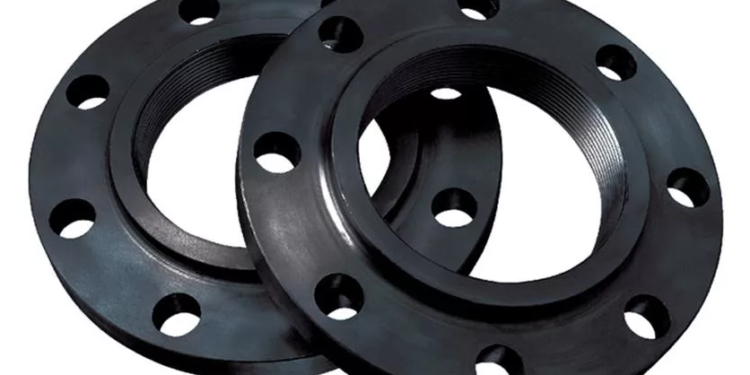Flanges are essential components in piping systems, providing reliable connections between pipes, valves, pumps, and other equipment. Among the many types available, Carbon Steel Flanges are widely used in various industries due to their strength, durability, and cost-effectiveness.
Whether you’re designing a pipeline for oil and gas, building a power plant, or working in water treatment, understanding the types and standards of carbon steel flanges is crucial. This blog explores the most common types of carbon steel flanges, their industrial uses, and the global standards they follow.
What Are Carbon Steel Flanges?
Carbon Steel Flanges are mechanical connectors made from carbon steel, a material known for its high strength and excellent performance in high-pressure and high-temperature environments. These flanges are used to connect pipes, facilitate cleaning and inspection, or allow easy modification of piping systems.
Carbon steel’s affordability, machinability, and tensile strength make it an ideal material for flanges used in industries such as oil & gas, petrochemical, power generation, and shipbuilding.
Common Types of Carbon Steel Flanges
Each type of flange has a specific function, and the choice depends on the application, pressure requirements, and environment. Here are the most widely used types of Carbon Steel Flanges:
1. Weld Neck Flange (WN)
Use: High-pressure applications
Feature: Long tapered hub for reinforcement
Advantage: Excellent stress distribution, ideal for high-temperature and pressure applications like refineries and power plants.
2. Slip-On Flange (SO)
Use: Low- to moderate-pressure systems
Feature: Slides over the pipe before welding
Advantage: Easy to align and install, cost-effective for general service applications.
3. Socket Weld Flange (SW)
Use: Small-diameter high-pressure pipes
Feature: Pipe is inserted into the socket and welded
Advantage: Strong weld, smooth bore flow, used in chemical processing and hydraulic systems.
4. Threaded Flange (TH)
Use: Low-pressure applications
Feature: Internal threads match with pipe threads
Advantage: No welding required; ideal for explosive environments where welding is risky.
5. Lap Joint Flange (LJ)
Use: Systems requiring frequent dismantling
Feature: Works with a stub end, not directly welded
Advantage: Cost-effective when using expensive alloy pipes; used in food, pharmaceutical, and chemical industries.
6. Blind Flange (BL)
Use: Close ends of piping systems
Feature: No bore in the center
Advantage: Allows pressure testing and isolation; often used in pipelines and pressure vessels.
7. Orifice Flange
Use: Flow measurement in pipelines
Feature: Comes with tapped holes for flow meters
Advantage: Accurate monitoring of flow rate in oil, gas, and chemical applications.
Global Standards for Carbon Steel Flanges
To ensure safety, compatibility, and performance, Carbon Steel Flanges are manufactured according to international standards. Let’s look at some of the key ones:
1. ASME/ANSI B16.5
- Covers flanges from ½ inch to 24 inches
- Pressure ratings: Class 150 to Class 2500
- Most commonly used in American and global industries
2. ASTM Standards
- ASTM A105: Forged carbon steel flanges for ambient- and high-temperature service
- ASTM A350: For low-temperature carbon steel flange applications
- ASTM A694: High-yield carbon steel flanges for high-pressure transmission service
3. DIN Standards (German)
- DIN 2633, DIN 2527, etc. define flange dimensions and materials
- Common in European and international markets
4. EN 1092-1 (European Norm)
- Specifies flange dimensions, materials, and face types
- Widely accepted in EU and global projects
5. JIS Standards (Japanese)
- Used in Japanese industrial systems
- Includes JIS B2220 for steel pipe flanges
Choosing a flange that complies with these standards ensures global compatibility, reliable performance, and ease of maintenance.
Industrial Applications of Carbon Steel Flanges
Due to their excellent strength and resilience, Carbon Steel Flanges are found in a wide variety of industries:
• Oil and Gas Industry
Used in pipelines, pressure vessels, and valves. Their resistance to high pressure and ability to withstand corrosive environments make them ideal for upstream and downstream systems.
• Power Generation
Used in steam lines, heat exchangers, and turbines. Weld neck and blind flanges are particularly common due to their pressure-handling capabilities.
• Chemical and Petrochemical Industry
Carbon steel flanges are suitable for many chemical processes that do not require exotic alloys. They connect process piping and ensure safe material handling.
• Shipbuilding and Marine
Resistant to stress and pressure, they are used in piping systems for cooling, ballast, and fuel supply lines on ships.
• Water and Wastewater Management
Slip-on and threaded flanges are used for ease of maintenance in potable water systems, drainage networks, and treatment plants.
Advantages of Carbon Steel Flanges
- Strength and Durability: Handle extreme conditions with minimal deformation or fatigue.
- Corrosion Resistance: Can be enhanced with coatings or alloying elements.
- Affordability: Lower cost compared to stainless steel or exotic alloys.
- Wide Availability: Easily sourced and available in standard dimensions and grades.
- Ease of Fabrication: Carbon steel is easy to cut, weld, and shape into precise fittings.
Choosing the Right Carbon Steel Flange
When selecting a carbon steel flange for your project, consider:
- Pressure rating (Class 150 to 2500)
- Temperature range
- Type of media (gas, liquid, corrosive chemicals)
- Pipe size and connection type (threaded, welded)
- Compliance with relevant standards (ASME, DIN, ASTM)
Consulting a trusted manufacturer or supplier can help ensure that your flanges meet technical specifications and safety standards.
Final Thoughts
Carbon Steel Flanges play a vital role in the efficiency and safety of industrial piping systems. With multiple types and a range of global standards, they offer versatile solutions for connecting and sealing pipework in high-pressure and high-temperature environments.
Understanding the various types and their applications helps engineers and project managers select the best flanges for their specific needs. Whether it’s a slip-on flange for a water line or a weld neck flange for a refinery, carbon steel flanges deliver strength, reliability, and cost efficiency across the board.












